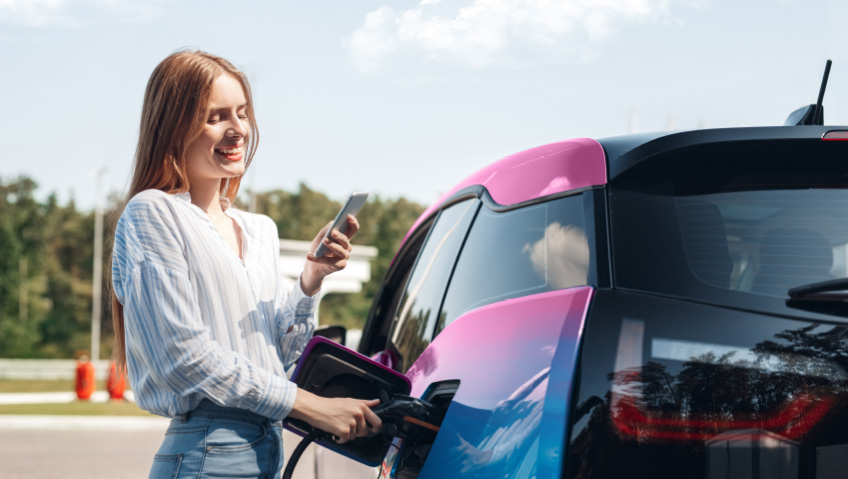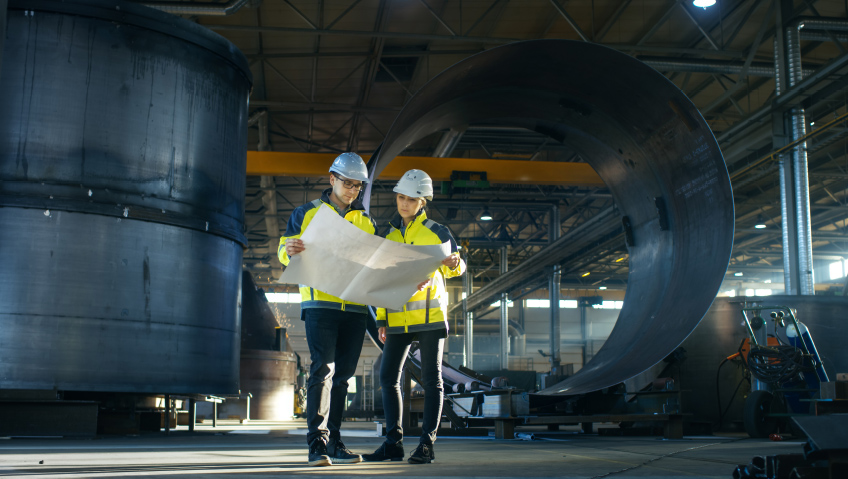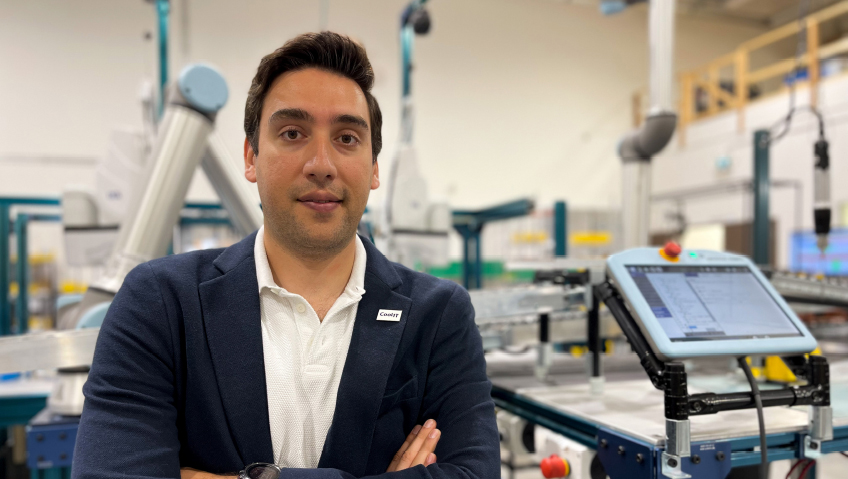You are driving along in your car, or, more accurately, your car is driving you along. You have set the car to fully autonomous so that you can lay back on the mattress which folds out for these trips, and it’s zipping along in electric-powered near silence. You were in a bubble gum-pink mood so that’s what you set your car’s color to before pulling out of your driveway with the plan to get caught up on that Netflix series that you haven’t had a chance to watch while you are on your way to your destination.
Sound far-fetched? Maybe not, if you are driving around in 2050. All those details about your drive are conceptualized through a collaboration between Auto Trader and Futurologist Tom Cheesewright, based on the rate of technology development, market trends and consumer demand.
Even the magical-sounding option to make your car bubble gum-pink is theoretically possible through a color changing e-ink paint which is millions of micro capsules filled with paint and negatively charged white pigments and positively charged black pigments that react when the electrical field is changed.
BMW recently showed off its iX concept car complete with stripes that change from white to gray to black across the car.
All of this sounds amazing, but we are just starting out on the road toward all these changes. By taking a closer look at where we are now, we may get a better picture of what cars may look like in the future – and what it means for manufacturers.
Let’s start with what will likely be the heart of most cars of the future, the battery. It’s no secret that the auto industry is moving toward electric vehicles (EVs). But while progress is being made, there are still many things that need to be improved to get to that futuristic picture of driving on autopilot.
In the 2021 Electric Vehicle Experience Ownership study by J.D. Power about EVs, the researchers confirmed that it was range that made the greatest difference in overall electric vehicle satisfaction among consumers. Commonly known as “range anxiety,” people want to feel sure that they are going to reach their destination without running out of charge.
And since electric vehicles have been built, which is longer than you may think, the real trick is making batteries that are able to hold more charge while taking up less room under the hood. Originally, EV batteries were produced using nickel and lead, but as the technology advanced, they have since evolved to being lithium-ion based, which you will find in most EVs now.
But lithium-ion is not the only battery in town. There are also solid state batteries.
Solid state and lithium-ion batteries look and function similarly, which is to say much better than their predecessors. But when you take a closer look at the two, solid state batteries, that get their name from having a solid core as opposed to the liquid core of lithium-ion ones, have a lot more going for them.
This solid core equates to a better charge rate of getting up to 80 percent in 15 minutes. Plus, solid state batteries don’t break down at nearly the same rate. Lithium-ion batteries start to degrade after 1,000 charge cycles, while solid state ones remain at 90 percent after 5,000 charge cycles. And perhaps most importantly for consumers who are nervous about trusting their batteries, there is the potential for it to extend the range of EVs significantly.
But like many things in life, there’s a catch. Right now, you are much more likely to see solid state batteries in watches and pacemakers which are clearly much smaller than automotive vehicles. The costs to scale them up to size is prohibitive. The hope is that as more research and development dollars are invested in solid state batteries, the less costly they will become to operationalize them in cars of the future.
So, while there is good progress underway, we may have to wait before we can jump into an EV and not worry about how far we are going.
The second big area that will separate our cars of the present from those of the future is autonomous functioning. Being able to simply hop into a car and punch in your destination (or even just tell it where you want to go), is a lot easier said than done.
Google started working on autonomous vehicles back in 2009. And Waymo – “a new way forward in mobility” – an autonomous driving technology company became part of the parent company, Alphabet, sometime after that. Since then, the company is still working away at the all the challenges that come with trying to navigate to a destination in various geography and conditions.
As an overly simplistic explanation, autonomous driving cars use cameras that can track what’s going on around the vehicle as it travels along. The car will then react to avoid potential objects. In addition, they use light detection ranging to estimate the distance between the car and another object.
But, after more than $100 billion invested into autonomous driving cars and years of testing, the whole technology has advanced quite slowly. The new hope is that Artificial Intelligence (AI) can take the massive amount of data that is required to make calculations and decisions on the road in a matter of milliseconds as well as have the car learn while it drives itself.
In an article for the MIT Technology Review, Raquel Urtasun, who led Uber’s self-driving efforts for four years, commented on the current state of autonomous-driving cars: “There is way too much overselling in this field.” She went on to add, “There is also a lack of acknowledgement of how difficult the task is in the first place.”
Manufacturers will need to evolve their production lines and their workforces to accommodate the super-acceleration of technology that comes into play for self-driving vehicles.
One of fundamental challenges is that humans and machines perceive and interpret the world differently. We humans see the road, hear the sirens, feel the motion, and make our decisions by some combination of intention and reaction – and each of us is different! One driver may not make the same decision as another, and some make better drivers than others, but we who drive seem to manage it fairly consistently. Accidents happen, of course.
With cameras and sensors, an automated system can also see, hear, and feel the world around it – perhaps even better than any human can – but the interpretation and of those collected measurements and then the decisions made from it are complex. It’s not a linear problem of adding up some conditions and reaching a result. It more like looking at a vast field of potential outcomes and picking the best path. Can an AI driver make better decisions than a human under the same conditions?
One of the most important questions that will need to be answered for autonomous cars is what does “safe enough” look like? In the U.K., the government is planning guidance in the form of a “safety ambition” for autonomous vehicles that will require them to be as safe as a human driver. Which may come as a relief to British motorists, but the criteria may be less about the science and more about what the public is willing to tolerate.
Moreover, accommodating autonomous cars on the road may mean changing the rules of the roads and maybe even the roads themselves to make conditions safe for all travelers. The U.K. Department for Transport has said that some cars, coaches, and trucks with self-driving features could even be operating on motorways in the next year.
With all that said, there is another side of the coin and it comes from one of the biggest players in the autonomous driving space, Tesla, and CEO Elon Musk who told participants at an energy conference in Norway in August, “The two technologies I am focused on, trying to ideally get done before the end of the year, are getting our Starship into orbit…and then having Tesla cars to be able to do self-driving.”
So maybe there is a breakthrough on the horizon after all.
The final piece in our car of the future is the driver experience. The emphasis may well be on the experience more than the driving. The beginning is how you communicate with your car. Voice recognition technology may enable us to simply talk to our cars. This is already happening for some of us when we say Hey Siri, or Alexa, but it’s not like we are talking about where we want to go and what we want to do on the way there.
But, as voice recognition becomes more sophisticated and plugs into a more advanced AI in your car, more things will be possible. And from there stepping into your car may be more like being in an airplane cabin with entertainment or work options as well as food and beverages. Screens as big as 30 inches are already being shown in some vehicles. It’s these bells and whistles that seem most likely to make an appearance in next-generation cars.
Ultimately, the utopian state of future car travel may not even be mainly about driving. If AI technology takes over, car drivers may become more like passengers with more free time as they drive to their destination in cars that produce virtually no emissions and improve overall safety for everyone.
Driving can become an opportunity to get more time for yourself, your phone and your coffee – without all the stress that comes from being on the road.






